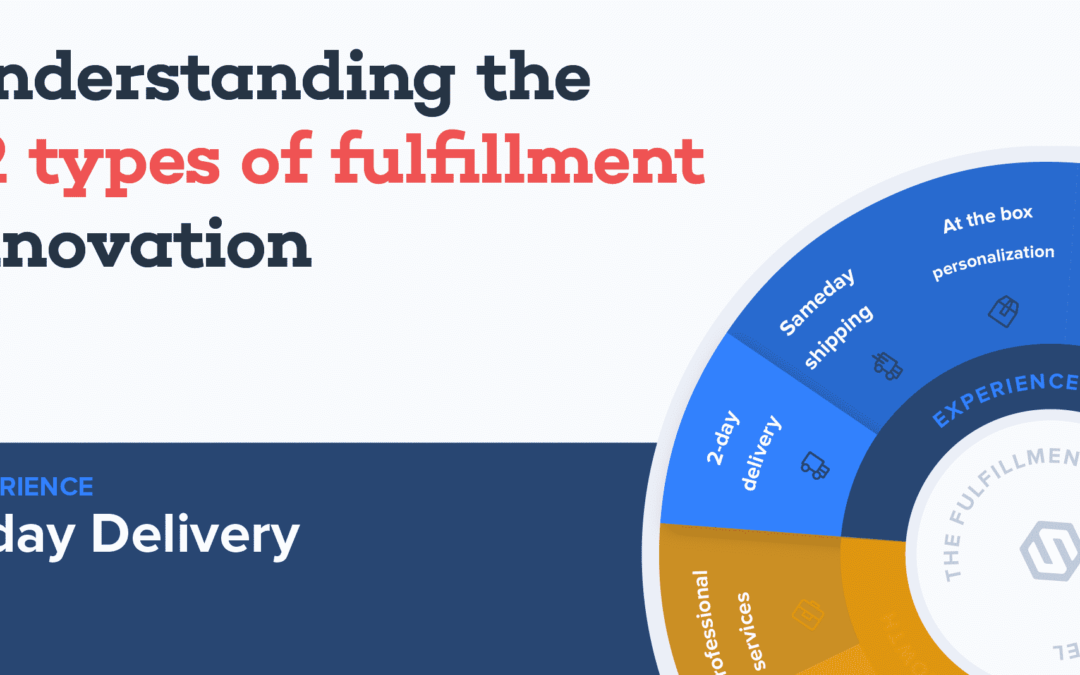
Mar 29, 2021 | Blog, The Fulfillment Innovation Wheel
ShipHero recently launched The Fulfillment Innovation Wheel to help 3PLs understand what capabilities and service offerings they need to implement in order to be successful and to help online retailers and brands choose which 3PL is right for them by allowing them to ‘check the boxes’.
The Fulfillment Innovation Wheel listed a set of twelve (12) capabilities that fulfillment providers and logistics companies should implement to continually delight their customers and push themselves towards greater success and innovation.
The twelve capabilities are:
- 2-Day Delivery
- Same Day Shipping
- At the Box Personalization
- Designed for Returns
- Sustainable Fulfillment
- Resilient Shipping
- Distributed Fulfillment
- Data Now
- Automation
- Scale Up and Out
- Integration Stack
- Professional Services
In this article, we will be diving into Capability #1: 2-Day delivery.
And be sure to stay tuned for future articles as we deep-dive into each capability.
Capability #1: 2-Day Delivery
Staying competitive in today’s eCommerce landscape is easy! From the moment when the customer clicks ‘Order’, you just need to be prepared to cover potentially hundreds of miles to deliver your products to their doorstep … in under 48 hours. Tick-tock!
2-day delivery has become the standard in eCommerce delivery, with major retailers like Amazon, Walmart, Target, and just about any business that wants to stay competitive all offering next-day delivery.
While the concept is simple, implementing 2-day delivery for your far-reaching customer base can be a huge undertaking. Not to mention, failing to meet this promise could result in irreparable damage to your credibility and brand.
So how can your business offer 2-day shipping? And what about sustainability?
Against the wishes of many environmentalists, the demand for speed and convenience has sky-rocketed during the COVID pandemic, with sustainability getting pushed to the wayside for more carbon-heavy transportations like air freight.
But will these carriers eventually have to pay the piper for their environmental footprint, and are there more sustainable options when it comes to 2-day shipping. Let’s dive in.
How Do Carriers Offer 2-Day Delivery?
Let’s first demystify what happens from the moment you click “Buy Now” until the package hits your doorstep.
First, your order information hits an order management system, which automatically transfers data to the appropriate fulfillment center based on inventory levels, warehouse capacity, cost and distance.
Next, a warehouse worker will be assigned to the order, with explicit instructions on how to pick the items, pack them in a box, and label the package correctly. The standard for getting this process completed is typically 24 hours.
From there, the order management system calculates the best shipping method based on carrier availability and cost. Depending on distance from the fulfillment center, the carrier will be air or ground freight. These are typically cargo planes or eighteen-wheeler trucks.
Once delivered to the closest distribution center, the package enters ‘last mile delivery’. Based on your address and the orders of your fellow consumers, the optimal route is calculated for delivery speed performance, and in rare cases, based on energy efficiency.
Finally, once those cute little delivery trucks arrive at your address, the mail carrier huffs it up your front steps and drops your package at your door. All the while, customers have been given access to real-time updates and tracking information so they can be with their package virtually every step of the way.
Phew, k you do that now. The eCommerce giants are able to offset the massive costs of offering free 2-day delivery in order to jockey for market position and win more customers, and sustainability is always an afterthought.
Through proper planning and partnering with the right fulfillment provider, your business can offer affordable and sustainable 2-day shipping to compete with the eCommerce elites. How? So glad you asked!
Your Guide to Affordable 2-Day Delivery
Ultimately, keeping 2-day delivery costs low while minimizing your carbon footprint comes down to the successful implementation of the following capabilities:
- Distributed Fulfillment
- Streamlined Pick-Pack-Ship
- Ground Priority
Distributed Fulfillment means intelligently bringing inventory closer to your customers through a distributed network of fulfillment centers placed around the country and/or globe. With the right Inventory Management System, you can forecast where your orders will come from and intelligently distribute your inventory accordingly.
With this in place, you can minimize the distance in which your products must travel, which reduces delivery times and gives you more flexibility in shipping options.
Streamlined Pick-Pack-Ship means not a second goes to waste when orders are sent to your warehouse. Full-service Warehouse Management Systems guide warehouse workers through every step of the process to eliminate human error and expedite getting packages out the door.
Ground Priority is achieved when your inventory is properly located and your warehouse operations run smoothly, so that you can offer more affordable and sustainable ground shipping every time, as opposed to resorting to costly and carbon-intensive air freight.
Wrap It Up
Does your business have the right tools in place to offer affordable and sustainable 2-day delivery? If not, then you may find it hard to compete in the future, especially as more and more people elect for eco-friendly businesses with the same suite of capabilities.
If you’re already working with a fulfillment provider or 3PL, make sure that they’re well-equipped for the task. If not, maybe it’s time for a switch.
Our customers love that ShipHero can offer 2-day ground delivery anywhere in the contiguous United States at simple and transparent pricing. We attribute this success on the Fulfillment Innovation Wheel to Capability #1: 2-Day Delivery.
Stay tuned next as we cover Capability #2: Data Now! It’s my data, and I need it now! ShipHero.
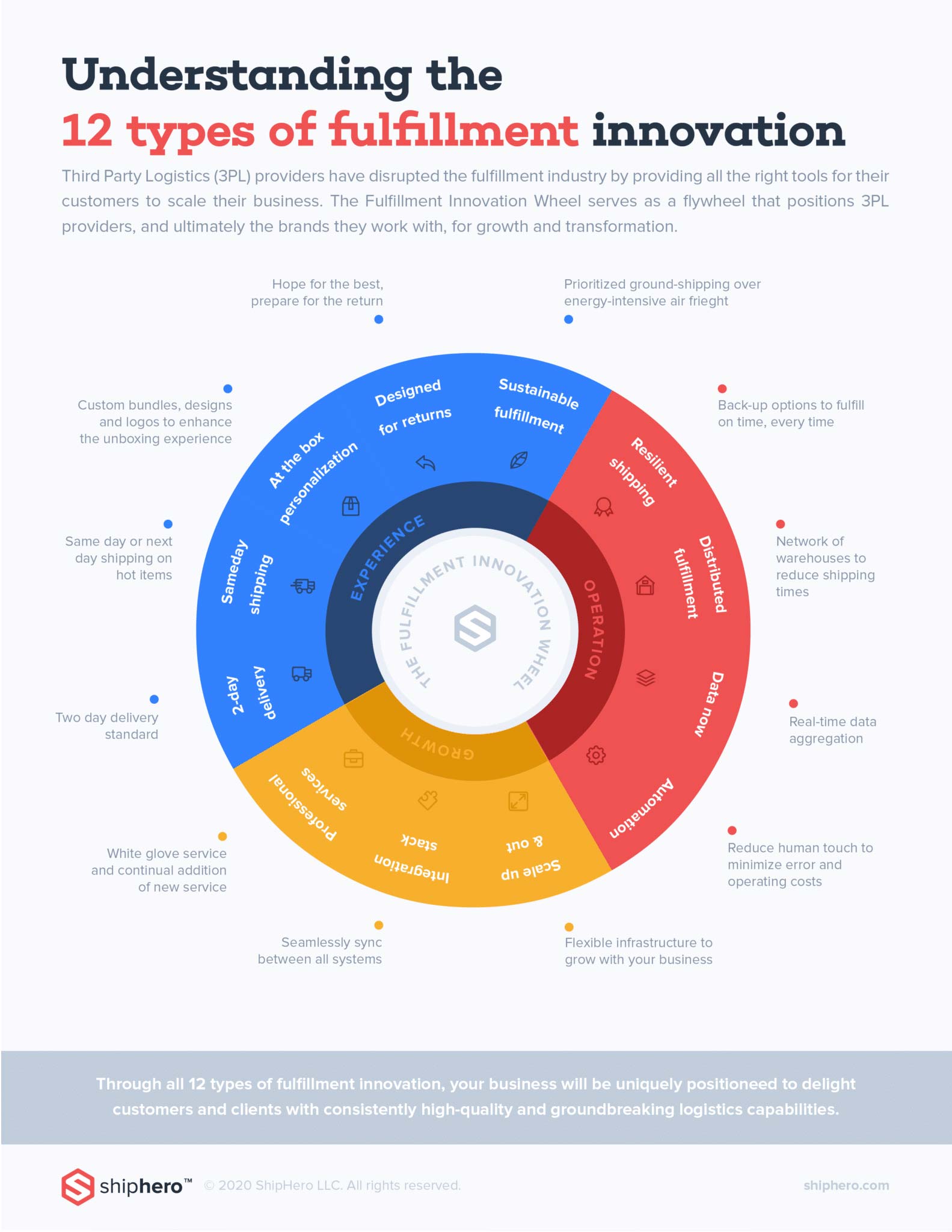
Learn more about ShipHero’s industry-leading warehouse management software.
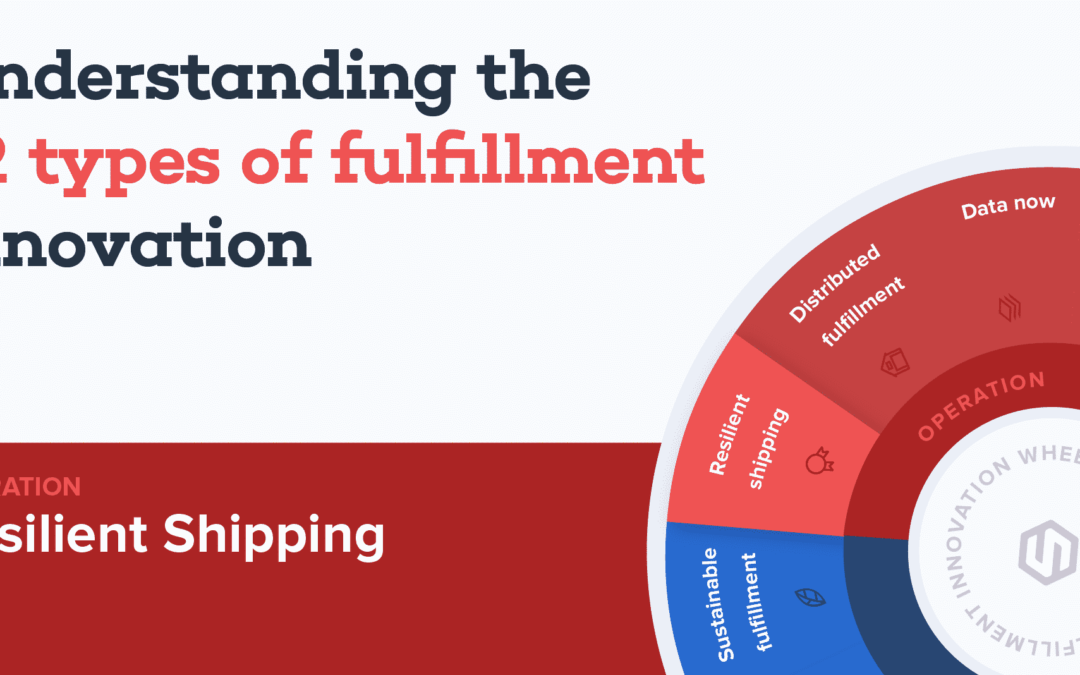
Mar 23, 2021 | Blog, Fulfillment, The Fulfillment Innovation Wheel
ShipHero recently launched The Fulfillment Innovation Wheel to help 3PLs understand what capabilities and service offerings they need to implement in order to be successful and to help online retailers and brands choose which 3PL is right for them by allowing them to ‘check the boxes’.
The Fulfillment Innovation Wheel listed a set of twelve (12) capabilities that fulfillment providers and logistics companies should implement to continually delight their customers and push themselves towards greater success and innovation.
The twelve capabilities are:
- 2-Day Delivery
- Same Day Shipping
- At the Box Personalization
- Designed for Returns
- Sustainable Fulfillment
- Resilient Shipping
- Distributed Fulfillment
- Data Now
- Automation
- Scale Up and Out
- Integration Stack
- Professional Services
In this article, we will be diving into Capability #6: Resilient Shipping.
And be sure to stay tuned for future articles as we deep-dive into each capability.
Capability #6: Resilient Shipping
Is your business sufficiently protected from supply chain risks like extreme weather events, supplier disruptions, and well… pandemics?
COVID-19 has certainly had an immense impact on global trade and domestic supply chains, but this hasn’t been an isolated incident, with SARS, measles, swine flu, ebola and avian flu all resulting in similar yet less severe business interruptions at a global level. Moreover, domestic supply chains are frequently plagued by extreme weather events, supply shortages, and carrier delays.
Supply chain resilience refers to a company’s ability to conduct normal business operations despite sudden disruptions or unexpected events that negatively affect supply chains and order fulfillment. Resilient supply chains are also able to quickly recover from outages and achieve pre-disruption levels of functionality.
As an example, many FBA merchants use ShipHero for FBM to avoid stock outs, maintain emergency inventory stockpiles, and provide diversified fulfillment options. In this article, let’s uncover how businesses can build a resilient supply chain and delivery network.
What Is a Resilient Supply Chain?
To start building your roadmap towards supply chain resiliency, you need to know what a resilient supply chain looks like. According to a recent study, these are the five core principles of a resilient supply chain:
- Rapid detection, response, and recovery. Your business must be able to quickly detect events, identify optimal response options, and achieve full-scale recovery.
- Complete oversight and control. Your business should have end-to-end visibility into your supply chain, along each step of the fulfillment journey, as well as the ability to take action quickly.
- Preparation for any scenario. Your business must prepare for a disruption before it happens with documented incident response plans, complete with specific steps and responsible parties for each scenario.
- Built-in redundancies and continuity. Your business must be able to account for process failures and bottlenecks, and provide additional surge capacity when disruptions arise.
- Intelligent demand planning. Your business can proactively avoid disaster scenarios with distributed fulfillment and effective inventory management.
Are these five principles present when looking at your own supply chain?
If you outsource your fulfillment, ensure that your fulfillment provider can guarantee a resilient supply chain with the above principles.
If your business fulfills in-house or you are a 3PL provider, consider building in the following practices for a resilient supply chain.
Building Supply Chain Resiliency
Hope for the best, plan for the worst. Your business can minimize damage from supply chain risks with the following best practices:
Map Out Your Fulfillment Processes
By documenting your end-to-end fulfillment process, you have a powerful visual tool to understand your supply chain and identify any possible pain points. Consider creating a process diagram and list relevant people at each step.
As for data, how does information flow through your supply chain? Is it automated? Or does it heavily rely on the copy/pasting of a single employee? By creating a full picture of how data flows through your supply chain, you can identify possible bottlenecks or dependencies that could inflict serious damage to your supply chain in times of crisis. Consider creating a process diagram of how data moves around your business (i.e., data flow diagram) and list relevant people at each step.
Get Inventory Insight and Control
Is your inventory where it should be at any given moment? Proper inventory management helps you avoid surplus inventory gathering dust on warehouse shelves and accumulating storage fees, while guarding against stock-outs and shortages in certain regions. Not to mention, intelligently distributed inventory allows you to reduce shipping costs and decrease delivery times.
Consider investing in modern inventory management software to get oversight and control of your inventory, or switch to a fulfillment provider, like ShipHero, that uses advanced warehouse management software across their network of fulfillment centers.
Build Automation Rules
In times of crisis, stressful or crunch-time decision making is very susceptible to human error. Automation can eliminate human interference in your core business processes, while leaving room for intervention when needed.
Consider implementing automation rules in your inventory management software; for example, automation rules can help place orders with the most cost-efficient suppliers when inventory hits certain levels, or automation can be used to choose the optimal delivery carrier when many face delays.
Provide Real-Time Collaboration
Do you have the ability to access and share supply chain information in real-time? Being able to access up-to-date information and reporting enables better decision-making and emergency planning. Consider implementing procedures and systems to get the right data to the right decision makers.
Manage Product Returns
Product returns introduce a lot of complications in your supply chain, including unpredictable inventory levels, increased costs, and reduced conversions — and this is amplified during situations of surging demand or delayed shipments. With a more effective return strategy (i.e., reverse logistics), your business will be more prepared for when the ship hits the fan.
Consider designing your supply chain and inventory management process with returns built in, or switching to a fulfillment provider that offers return credit and advanced reverse logistics capabilities.
Wrap up
With the above best practices in place, your data-driven supply chain will be optimized for resiliency, and be able to quickly detect, respond to, and recover from any sudden supply chain disruptions.
Our customers love that ShipHero provides a resilient and data-driven supply chain that can offer 2-day shipping anywhere in the contiguous United States at simple and transparent pricing. We also prioritize ground shipping, making for an eco-friendly supply chain. We attribute this success on the Fulfillment Innovation Wheel to Capability #6: Resilient Shipping.
Stay tuned next as we cover Capability #1: 2-day Delivery! Get 2-day, today. ShipHero.

Learn more about ShipHero’s industry-leading warehouse management software.
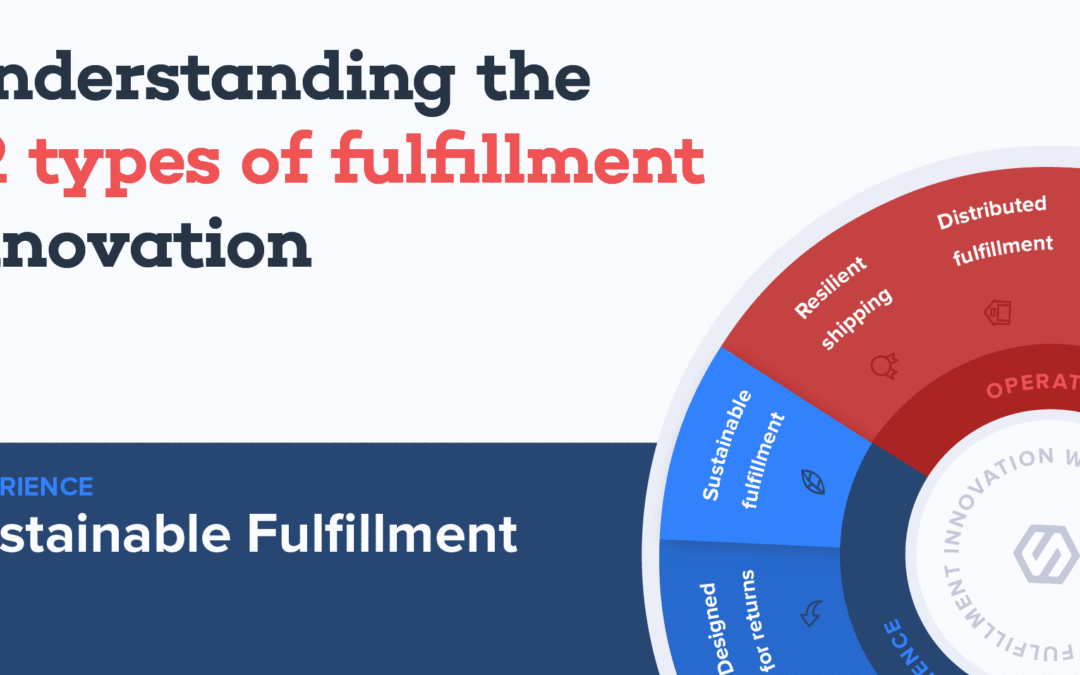
Mar 12, 2021 | Blog, The Fulfillment Innovation Wheel
ShipHero recently launched The Fulfillment Innovation Wheel to help 3PLs understand what capabilities and service offerings they need to implement in order to be successful and to help online retailers and brands choose which 3PL is right for them by allowing them to ‘check the boxes’.
The Fulfillment Innovation Wheel listed a set of twelve (12) capabilities that fulfillment providers and logistics companies should implement to continually delight their customers and push themselves towards greater success and innovation.
The twelve capabilities are:
- 2-Day Delivery
- Same Day Shipping
- At the Box Personalization
- Designed for Returns
- Sustainable Fulfillment
- Resilient Shipping
- Distributed Fulfillment
- Data Now
- Automation
- Scale Up and Out
- Integration Stack
- Professional Services
In this article, we will be diving into Capability #5: Sustainable fulfillment.
And be sure to stay tuned for future articles as we deep-dive into each capability.
Capability #5: Sustainable Fulfillment
Cut down your company’s waste, improve your brand image. Sounds like a win-win, doesn’t it? That’s the power of Sustainable Fulfillment — eCommerce order fulfillment that minimizes the environmental impacts of your supply chain.
eCommerce waste is a much more serious problem than you think. In 2018, the EPA estimated that packaging accounts for about 30% of all household waste. Moreover, with packaging made from plastics, only 9% of all plastics has ever been recycled, with the rest ending up in our oceans, forests, and landfills.
Beyond the harm to the environment, inconsiderate packaging hurts your brand reputation as well. Think back to opening a large box to find a much smaller product inside, or individually-wrapped parts, and thinking “what a waste!”.
Poor packaging leads to brands being labeled as inconsiderate or wasteful, and in a world where GenZ-types and Greta Thunberg’s run wild, your company should avoid this image at all costs.
So, how can your company achieve Sustainable Fulfillment? The answer lies in using proper packaging, planning intelligent shipping, and bringing awareness to your customer base.
How to Create Sustainable Fulfillment
If you fulfill orders in-house, you can reference the list below to achieve Sustainable Fulfilment. If you use a 3PL or third-party fulfillment provider, be sure that they have taken the necessary steps to create Sustainable Fulfillment for your business.
Sustainable eCommerce Packaging
Right-size packaging and eco-friendly packaging for your products is a necessary step towards Sustainable Fulfillment. More and more eCommerce businesses are using on-demand packaging for their products, and eliminating over-boxing by shipping the product in its original carton.
Right-size packaging means avoiding product packaging that is exorbitantly larger than the product itself, or eliminating excess materials or fillers.
Eco-friendly packaging means using recycled or renewable materials that are biodegradable or easily disposed of.
Your company may use large packaging with fillers to avoid damaging the product, but with breakthroughs in reusable and recyclable eCommerce packaging, you can avoid the damage while offering a great unboxing experience.
Companies like NoIssue exist to create sustainable, customized packaging.
Intelligent Order Fulfillment & Routing
Carbon emissions from transportation are another major source of waste in your supply chain. Last mile delivery and air freight make up a majority of carbon emissions in logistics, so transportation optimization and intelligent inventory management are significant ways of reducing your carbon footprint.
Transportation Optimization starts at the distribution center. By using Warehouse or Order Management Software (WMS/OMS) to route your orders correctly, your company can identify the most viable distribution center to ship orders in terms of delivery speed and cost. Additionally, last-mile delivery routes should be calculated to reduce mileage and ensure the most energy-efficient routes are selected.
Intelligent Inventory Management means that your inventory is placed in the warehouse closest to your customers, also known as distributed fulfillment, to reduce shipping distance and costs. Also, using WMS/OMS to ensure that orders are picked, packed and loaded correctly helps to reduce returns, reroutes and expedited shipping.
Our clients have used the above two strategies to lower the carbon footprint of our clients fulfillment while still guaranteeing affordable two-day shipping, powered by ShipHero SaaS Warehouse Management Software.
Our clients use our proprietary inventory forecasting capability to intelligently distribute their inventory across our nationwide network of warehouses. From there, we help them prioritize ground-shipping and avoid wasteful air-freight and expedited shipping. Not to mention, our clients use our SaaS WMS to accurately pick, pick and ship orders all from their tablet or mobile device.
Spread Awareness
Once your business has adopted Sustainable Fulfillment, the final step is to educate your customers! If you use recyclable materials, let your customers know so they can ensure responsible disposal and feel part of the solution. By getting customers on board with your eco-friendly efforts, you can have a much wider positive impact on the environment as a business.
You should advertise the steps you’ve taken towards Sustainable Fulfillment, and consider using packaging inserts in your orders that explain why your business took these steps and what customers can do to help. Adding this packaging insert has little to no added disruption to your fulfillment process, and it is a phenomenal way to reduce waste and improve your brand.
Our customers love that ShipHero allows them to completely customize their boxing experience, including packaging, inserts, and materials. If your 3PL or fulfillment provider doesn’t offer this, then maybe it’s time for a switch. ShipHero has $5 billion in orders shipped to date, and we attribute this success on the Fulfillment Innovation Wheel to Capability #5: Sustainable Fulfillment.

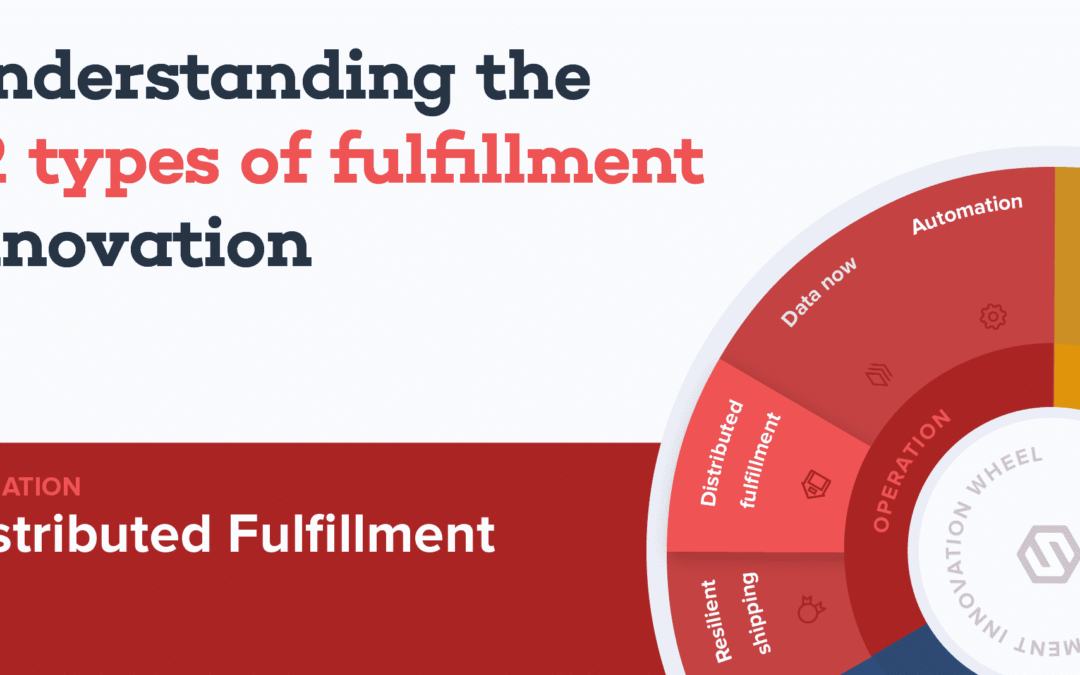
Mar 3, 2021 | Blog, Fulfillment, The Fulfillment Innovation Wheel
ShipHero recently launched The Fulfillment Innovation Wheel to help 3PLs understand what capabilities and service offerings they need to implement in order to be successful and to help online retailers and brands choose which 3PL is right for them by allowing them to ‘check the boxes’.
The Fulfillment Innovation Wheel listed a set of twelve (12) capabilities that fulfillment providers and logistics companies should implement to continually delight their customers and push themselves towards greater success and innovation.
The twelve capabilities are:
- 2-Day Delivery
- Same Day Shipping
- At the Box Personalization
- Designed for Returns
- Sustainable Fulfillment
- Resilient Shipping
- Distributed Fulfillment
- Data Now
- Automation
- Scale Up and Out
- Integration Stack
- Professional Services
In this article, we will be diving into Capability #7: Distributed fulfillment.
And be sure to stay tuned for future articles as we deep-dive into each capability.
Capability #7: Distributed Fulfillment
Quiz for the e-commerce gurus out there. Which of these two options makes more sense from a business standpoint: Deliver your products from nearby OR deliver your products from far away? Take your time, we all don’t have MBAs.
Businesses who want to reduce delivery times and keep costs low will opt to deliver their products from a nearby location, but as an online business reachable by customers all over the United States, how is that possible? The solution: Distributed Fulfillment.
Distributed Fulfillment is the secret to how the e-commerce giants can deliver free 1-2 day shipping nationwide, and the concept is simple: intelligently bring inventory and fulfillment centers closer to your customers.
The advantages of distributed fulfillment are:
Optimized Price and Delivery Speed
Reducing the distance between fulfillment centers and your customer’s doorstep leads to lower costs, faster delivery times, and reduced carbon emissions. This also allows your business to offer free shipping or guaranteed two-day shipping, which are huge online purchase drivers and pretty much the standard in today’s market.
Easy to Manage
With the right tools in place, managing your inventory is simple. Warehousing companies and fulfillment providers like ShipHero offer Warehouse Management Software (WMS) to give business owners complete oversight and control into their supply chain, so that they can make intelligent decisions on where to store their inventory and how to ship their product.
Reliable and Resilient Shipping
Don’t be at the mercy of mother nature or shipping bottlenecks from traditional carriers. Distributed fulfillment gives you a diversified and robust supply chain that you and your customers can rely on to ship, no matter the circumstance.
In-House vs. Outsourced
For all these reasons, e-commerce giants like Amazon and Walmart are successfully employing this logistics model for e-commerce fulfillment and retailers that piggyback off of their distributed fulfillment network seeing fantastic results.
For in-house fulfilment (i.e., creating a fulfillment network yourself), a high amount of initial capital is required to lease warehouse space across the country, distribute the inventory, then continuously monitor and optimize your inventory management and order fulfillment.
Luckily for small to medium-sized businesses looking to compete, 3PLs and outsourced fulfillment providers like ShipHero are creating massive distributed fulfillment networks around the country, and are ready to deliver your e-commerce.
Our customers love that ShipHero can easily offer 2-day shipping anywhere in the contiguous United States at simple and transparent pricing. We are also able to prioritize ground shipping, making for a resilient and eco-friendly supply chain. We attribute this success on the Fulfillment Innovation Wheel to Capability #7: Distributed Fulfillment.
Stay tuned next as we cover Capability #7: Resilient Shipping! Viva la Resilience. ShipHero.

Learn more about ShipHero’s industry-leading warehouse management software.
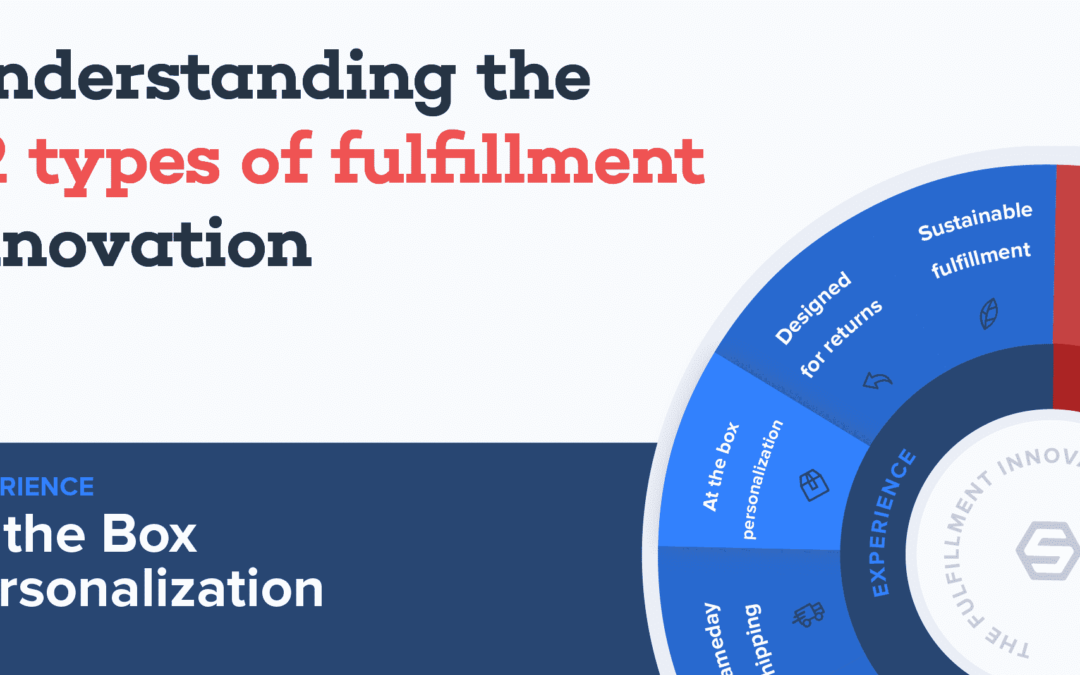
Feb 25, 2021 | Blog, The Fulfillment Innovation Wheel
ShipHero recently launched The Fulfillment Innovation Wheel to help 3PLs understand what capabilities and service offerings they need to implement in order to be successful and to help online retailers and brands choose which 3PL is right for them by allowing them to ‘check the boxes’.
The Fulfillment Innovation Wheel listed a set of twelve (12) capabilities that fulfillment providers and logistics companies should implement to continually delight their customers and push themselves towards greater success and innovation.
The twelve capabilities are:
- 2-Day Delivery
- Same Day Shipping
- At the Box Personalization
- Designed for Returns
- Sustainable Fulfillment
- Resilient Shipping
- Distributed Fulfillment
- Data Now
- Automation
- Scale Up and Out
- Integration Stack
- Professional Services
In this article, we will be diving into Capability #3: At the box personalization.
And be sure to stay tuned for future articles as we deep-dive into each capability.
Capability #3: At the Box Personalization
At the Box Personalization is all the little details in your product’s unboxing experience that truly make customers fall in love with your brand. Imagine getting an unexpected hand-written note, a coupon, or a gift in the box along with your order.
All the excitement and gratitude experienced by the thoughtful presentation of your items generates customer loyalty, while also providing a targeted marketing channel for cross-sell and upsell of items. Not to mention, 59% of Americans receive packages weekly, and 10% receive packages daily. That is quite a large marketing audience in terms of packaging…
By pairing At the Box Personalization with modern-day customer data and analysis, retailers can give more personal, more thoughtful experiences than ever before; say, a gift that they truly love or a coupon for an item they had considered purchasing. You may not sell to Brad Pitt, but your customers will be screaming “WHAT’S IN THE BOX” every time they open your package with these benefits of At the Box Personalization:
Spread Your Brand Organically
Corporations have been successfully using At the Box Personalization for decades, with some customers fully relying on Youtube unboxing videos to guide their purchases, and you can see unboxing ideas all over on Pinterest.
Drive Customer Loyalty
In today’s competitive e-commerce market, most retailers do not manufacture unique goods, so your market differentiators are going to live in that extra ‘wow factor’. At the Box Personalization is proven to cultivate brand loyalty and give customers that jolt of consumer surplus that only comes with getting more bang for your buck — that’s right, we’ve all been conditioned by the Happy Meals toy.
Create Sales Opportunity
Along with the purchased item, retailers can incentivize cross-selling and upselling other products, essentially transforming your packaging into a targeted marketing channel. You can include coupons for relevant or wishlist items, or you can include a gift that requires purchase of other features or parts. And because this occurs in the post-sale phase of the buyer’s journey, it won’t come off as another sales gimmick.
The sky is truly the limit when providing high-quality personalization to your customers, so don’t get weighed down by your 3PL or fulfillment provider. Many fulfillment providers today simply do not provide At the Box Personalization because it reduces efficiency and increases costs.
However, smart fulfillment companies like ShipHero continually innovate their capabilities to offer you a wide range of At the Box Personalization options. Our customers love that ShipHero can easily customize their unboxing experience. We attribute this success on the Fulfillment Innovation Wheel to Capability #3: At the Box Personalization.
Stay tuned next as we cover Capability #7: Distributed Fulfillment! Fulfill Your Dreams… Everywhere. ShipHero.

Learn more about ShipHero’s industry-leading warehouse management software.
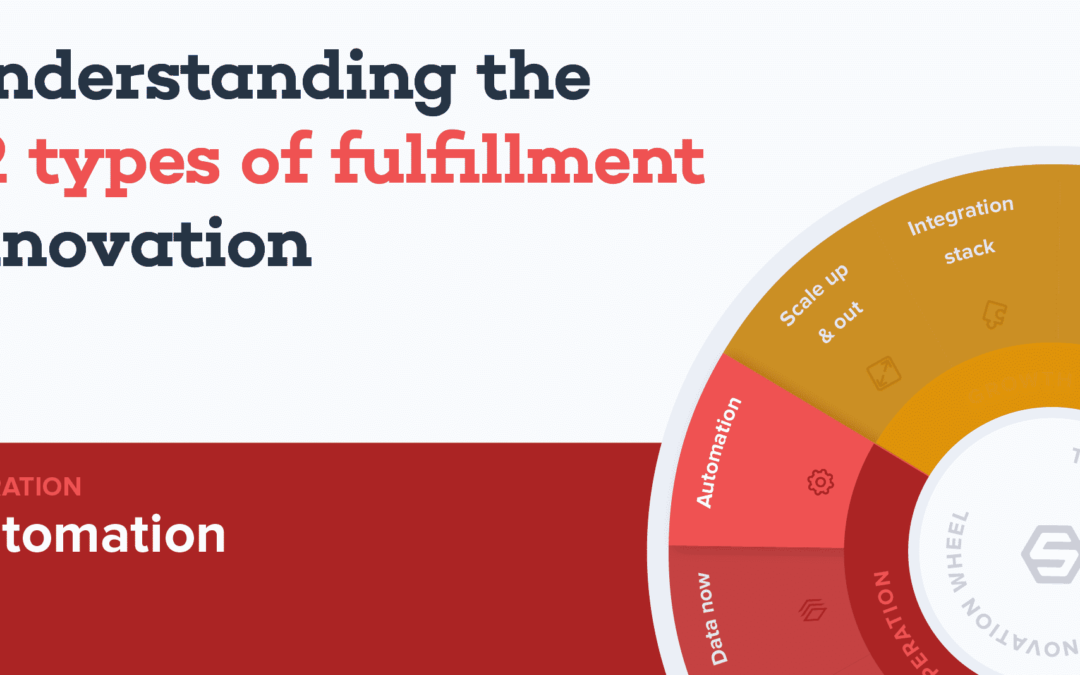
Feb 18, 2021 | Blog, The Fulfillment Innovation Wheel
ShipHero recently launched The Fulfillment Innovation Wheel to help 3PLs understand what capabilities and service offerings they need to implement in order to be successful and to help online retailers and brands choose which 3PL is right for them by allowing them to ‘check the boxes’.
The Fulfillment Innovation Wheel listed a set of twelve (12) capabilities that fulfillment providers and logistics companies should implement to continually delight their customers and push themselves towards greater success and innovation.
The twelve capabilities are:
- 2-Day Delivery
- Same Day Shipping
- At the Box Personalization
- Designed for Returns
- Sustainable Fulfillment
- Resilient Shipping
- Distributed Fulfillment
- Data Now
- Automation
- Scale Up and Out
- Integration Stack
- Professional Services
In this article, we will be diving into Capability #9: Automation.
And be sure to stay tuned for future articles as we deep-dive into each capability.
Capability #9: Automation
The mundane, the menial, the humdrum, the everyday monotony… these are the types of business activities that should and could be automated. Why spend your valuable time copy and pasting shipping information across your systems? Or manually inputting return information? Or constantly checking inventory levels? Let automation work for you!
As a business owner, your fulfillment provider should also understand that your time is your most valuable resource. If you are just starting out, you may be able to manually handle it all on your own. But when your business grows bigger and bigger, and the orders are rolling in, you risk spreading yourself too thin, giving yourself no time to get your head above water and focus on your business’s long-term strategy.
If you get to the point where the everyday tasks of your fulfillment process seems to be your only focus, it’s definitely the right time to switch to a fulfillment provider that can automate these for you.
ShipHero’s Automation Cookbook
For that reason, ShipHero has partnered with Alloy to unlock smart automations that improve inventory control and warehouse operations with just a few clicks, while integrating ShipHero with 60+ apps to improve the fulfillment experience and grow your business.
The few example recipes below from ShipHero’s automation cookbook give you a glimpse at the power of automation between workflows, and may enlighten you to possibilities you never thought possible.
Recipe: Send reorder emails or Slack notifications to staff for low inventory in ShipHero
Our workflow automates reorder emails to be sent to staff when there is low inventory in ShipHero. This ensures that your team can restock inventory at a reasonable pace and without over-stocking, and is a great way to organize the flow of customer traffic and inventory.
Recipe: Tag Shopify orders based on ShipHero delivery date
This workflow tags Shopify orders based on the ShipHero delivery date. This means that all orders are tagged by date allowing you to view which days are busy and how many orders are expected to ship out weekly. Tagging orders is a good way to stay organized especially when your store is expanding globally and there are multiple orders placed on the same day.
Recipe: Set a ShipHero threshold to notify store owner of low inventory
This workflow notifies you when your inventory is low in ShipHero. For instance, inventory levels are updated regularly and you receive inventory levels for each inventory item. When stock is low, you receive a notification. Immediate notifications to store owners are key to restocking your inventory and satisfying your eager customers. These notifications can be sent through Slack and email.
Recipe: If an order is still unfulfilled in ShipHero after 2 days, email me
This automation will schedule a workflow after 2 days. Then, it will check to see if the order is unfulfilled for greater than or equal to 2 days. This will trigger an email notification to the store owner. This frees you up from constantly checking the fulfillment status of your orders.
Recipe: Automate fulfillment for Gorgias returns requests in ShipHero
This workflow automates fulfillment for Gorgias return requests in ShipHero. When a customer requests a return on Shippo, a Gorgias request is immediately created and sent. This frees up time from going back and forth between Shippo and Gorgias and ensures no information is lost.
Recipe: Cancel ShipHero scheduled delivery if there is a Gorgias request
With this automation, customers can send in a support ticket for a cancellation request. Once your team marks it as a canceled order, an email is sent to the ShipHero fulfillment team so they won’t fulfill the order.
Recipe: Send ShipHero delivery updates via Klaviyo SMS
SMS messages can have open rates as high as 98% and you’re not limited to using them for promotional campaigns. With this workflow, you can send delivery updates to customers through a text message to leverage higher open and engagement rates.
In addition to the above, Alloy also has delivery update automations for Omnisend SMS, PostScript, SMSBump, and Tone, and more integrations are created all the time.
Our customers love the automation capabilities that ShipHero provides. We attribute this success on the Fulfillment Innovation Wheel to Capability #10: Automation.
Stay tuned next as we cover Capability #6: Resilient Shipping! Viva la resilience. ShipHero.

Learn more about ShipHero’s industry-leading warehouse management software.
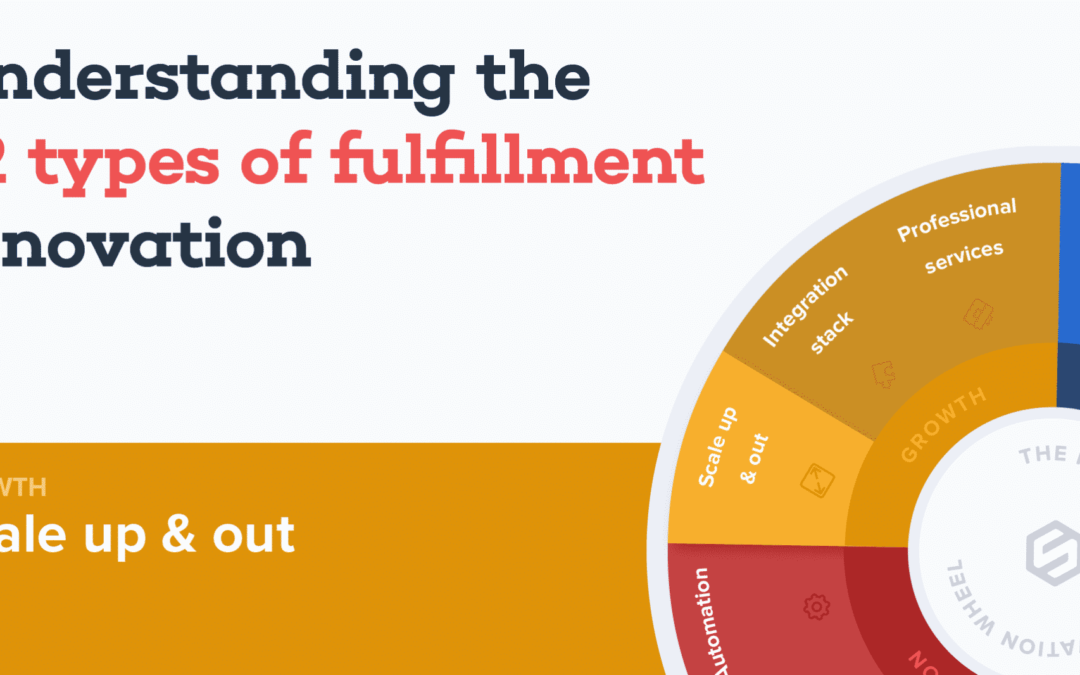
Feb 1, 2021 | Blog, The Fulfillment Innovation Wheel
ShipHero recently launched The Fulfillment Innovation Wheel to help 3PLs understand what capabilities and service offerings they need to implement in order to be successful and to help online retailers and brands choose which 3PL is right for them by allowing them to ‘check the boxes’.
The Fulfillment Innovation Wheel listed a set of twelve (12) capabilities that fulfillment providers and logistics companies should implement to continually delight their customers and push themselves towards greater success and innovation.
The twelve capabilities are:
- 2-Day Delivery
- Same Day Shipping
- At the Box Personalization
- Designed for Returns
- Sustainable Fulfillment
- Resilient Shipping
- Distributed Fulfillment
- Data Now
- Automation
- Scale Up and Out
- Integration Stack
- Professional Services
In this article, we will be diving into the Capability #10: Scale Up and Out.
And be sure to stay tuned for future articles as we deep-dive into each capability.
Capability #10: Scale Up and Out
Your business constantly strives for growth. Whether it’s new customers, new markets, new products, your quest for innovating and providing more value seemingly never ends. Shouldn’t you ask the same of your fulfillment providers?
Without clear-cut criteria and a well-executed strategy for growth, your fulfillment provider could slow your business down. As we saw with this global pandemic, traditional shipping carriers like FedEx, UPS, and even Amazon could not scale quickly enough to meet the soaring demands of the eCommerce boom.
Conversely, FaaS providers and third-party logistics (3PL) companies like ShipHero that were built for scale, equipped with agile development processes and defined expansion strategies, not only experienced tremendous growth and innovation but were able to deliver for their customers when others could not.
We attribute this success on the Fulfillment Innovation Wheel to Capability #10: Scale Up and Out.
The Data-Driven Approach
First and foremost, through real-time data monitoring and executive reporting, your fulfillment provider should get the right data to the decision-makers, so that they can make the best possible decisions when it comes to expansion. Let the data tell you when it’s time to expand, because over-expansion is a kiss of death all on its own.
Make sure you are tracking the data that tells the real story, like ‘Miles Travelled per Order’ or ‘Time to Fulfill’; whatever it may be for your business. Remember, locking in new warehouses to your network is expensive and very difficult to undo, so you need to ensure that there are no simple fixes for your current fulfillment capacity.
At ShipHero, we have clearly defined criteria that informs us when it’s time to expand our operations. We know it’s time to expand when one of the following happens:
- We reach physical storage limits for inventory
- We reach shipping capacity, in terms of the amount of orders that can be shipped in a day
- We recognize regional bottleneck trends, e.g., a distribution center on the East Coast is frequently shipping to the West Coast
If you are a 3PL or FaaS provider, be sure to collect the right data and set clear-cut goals for expansion.
If you are a customer looking to outsource fulfillment, make sure that your fulfillment provider has these in mind, and can grow as quickly you do.
Want to learn more? Some content from this article was borrowed from our previous article: Warehouse Buying 101: A Guide to Scalability, where we dive deeper into the expansion strategy that launched us to become trusted by over 4,000 ecommerce brands and 3PLs every day, in just under a year.
Stay tuned next as we cover Capability #12: Professional Services! At your service. ShipHero.

Learn more about ShipHero’s industry-leading warehouse management software.
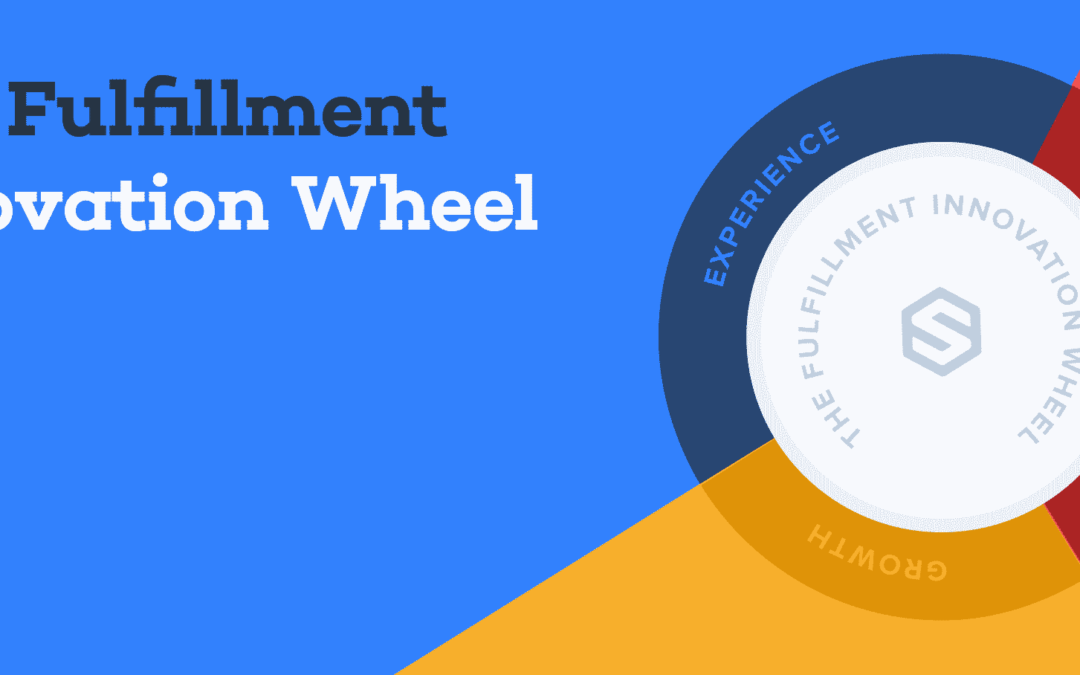
Jan 19, 2021 | Blog, The Fulfillment Innovation Wheel

It’s no secret that today’s world of ecommerce is changing rapidly. Third party logistics (3PL) and fulfillment providers that don’t find a way to keep up with, if not surpass, the pace of growth during this ecommerce boom is at serious risk of getting left behind.
That’s why we invented The Fulfillment Innovation Wheel: to help 3PLs understand what capabilities and service offerings they need to implement in order to be successful, and to help online retailers and brands choose which 3PL is right for them by allowing them to ‘check the boxes’.
We studied the most successful 3PLs and fulfillment providers in the industry to understand what sets them apart. The answer was that they understood their mission, and they used this set of 12 capabilities as a flywheel to continually delight their customers and push themselves towards greater success and innovation.
Each and every 3PL we observed invested heavily in certain capabilities like personalization, delivery speed or frictionless returns, but always satisfied their client’s basic requirements for every capability on the flywheel. And always, the main focus was on Customer Experience, Growth and Scalability, and Operational Excellence.
Without further ado, we present The Fulfillment Innovation Wheel!
To view all blogs in this series, click the links below:
- 2-Day Delivery
- Same Day Shipping
- At the Box Personalization
- Designed for Returns
- Sustainable Fulfillment
- Resilient Shipping
- Distributed Fulfillment
- Data Now
- Automation
- Scale Up and Out
- Integration Stack
- Professional Services
Learn more about ShipHero’s industry-leading warehouse management software.
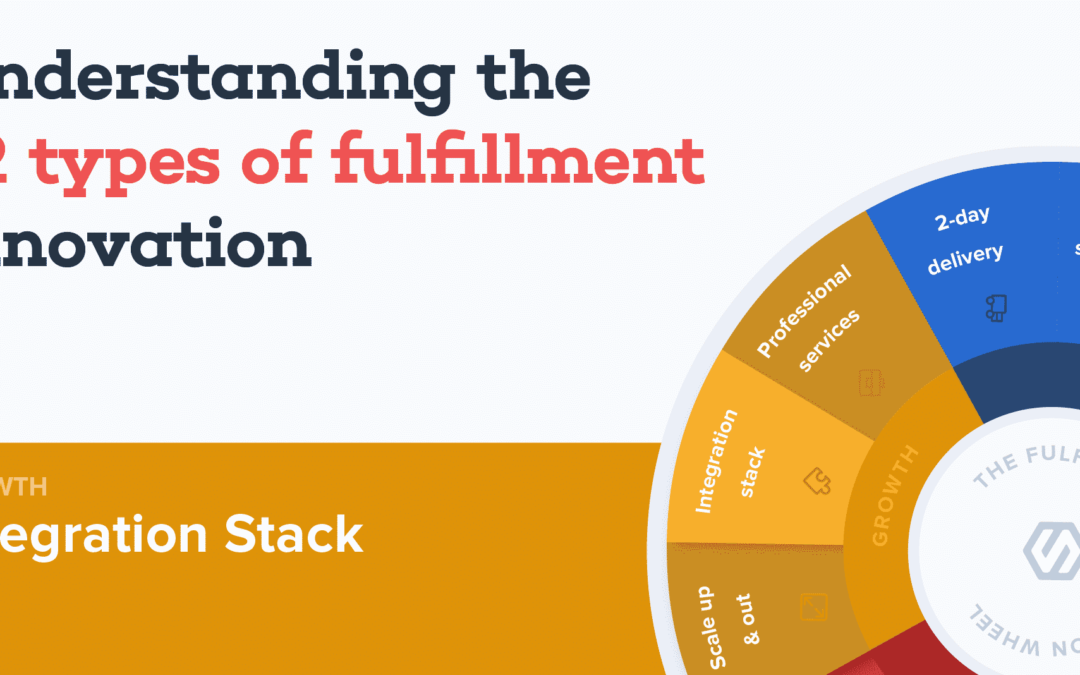
Feb 10, 2021 | Blog, The Fulfillment Innovation Wheel
ShipHero recently launched The Fulfillment Innovation Wheel to help 3PLs understand what capabilities and service offerings they need to implement in order to be successful and to help online retailers and brands choose which 3PL is right for them by allowing them to ‘check the boxes’.
The Fulfillment Innovation Wheel listed a set of twelve (12) capabilities that fulfillment providers and logistics companies should implement to continually delight their customers and push themselves towards greater success and innovation.
The twelve capabilities are:
- 2-Day Delivery
- Same Day Shipping
- At the Box Personalization
- Designed for Returns
- Sustainable Fulfillment
- Resilient Shipping
- Distributed Fulfillment
- Data Now
- Automation
- Scale Up and Out
- Integration Stack
- Professional Services
In this article, we will be diving into Capability #11: Integration Stack.
And be sure to stay tuned for future articles as we deep-dive into each capability.
Capability #11: Integration Stack
These days, all you need to start an online business is a laptop and a dream. With just a few clicks, more and more people are chasing their entrepreneurial passions by leveraging eCommerce platforms like Shopify, Wix and Squarespace, which provide all the software solutions that they need to get their business up and running.
Online businesses today are piecemealed together by a whole assortment of cloud applications, created by different app developers with different methodologies, to accomplish a specific task, e.g, returns, transactional emails, shipping labels, etc. However, without a way to tie them all together, the benefits from the expertise are lost when the entrepreneur is forced to spend enormous effort in navigating from one app to another, figuring out how to transfer information between all of their tools.
So, the eCommerce platforms like Shopify are not inherently powerful in and of themselves; rather, the real power of these platforms lies in their ability to integrate seamlessly with multiple solutions, tying in expertise from a whole plethora of applications that are otherwise customized to do one, specific thing.
Similarly, fulfillment providers need to be able to integrate seamlessly into your business, not to mention offer automation tools to speed up your workflows, leaving you time to focus on what really matters.
The Fulfillment Integration Stack
Retailers have come to expect that their fulfillment provider integrates into the platforms and applications that they are already using, allowing them to transfer data cross-applications and simplify their business processes. However, this is often no easy task.
Only 3PLs and fulfillment providers that are born from agile methodologies and built to scale can offer the wide-ranging integration methods that retailers demand. Without them, they will only slow down your business and as the old adage goes: time is money.
ShipHero’s integration marketplace offers a suite of valuable integrations that make it easy to connect our customers to a long list of shipping carriers and ecommerce platforms. As seen with our recent integrations with Alloy and Returnly, ShipHero is constantly expanding our capabilities and partnering with companies so that our customers have the very best options when it comes to easy, one-click integrations.
Along with our direct integrations, we also have over 20 partners that provide integrations and systems expertise, as well as an open API so that users can code their own integrations and webhooks if it’s not already on our list.
Our customers love the integration that ShipHero provides. We attribute this success on the Fulfillment Innovation Wheel to Capability #11: Integration Stack.
Stay tuned next as we cover Capability #12: Professional Services! At your service, professionally. ShipHero.

Learn more about ShipHero’s industry-leading warehouse management software.
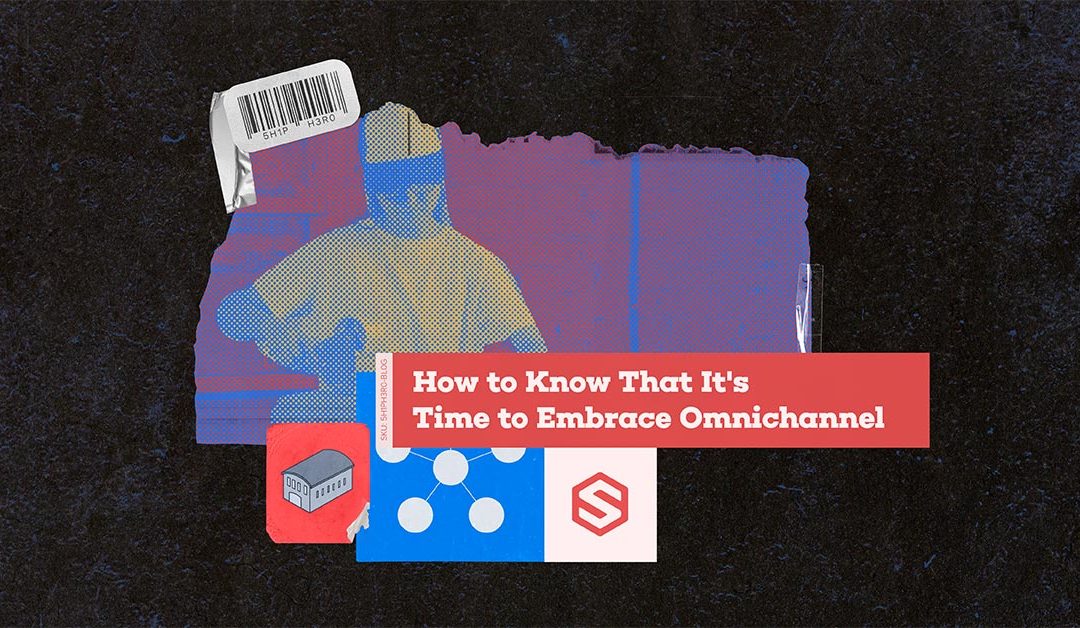
Mar 28, 2022 | Blog
By: Aaron Rubin, Founder & CEO of ShipHero
As online shopping continues to ramp up, more eCommerce brands are rethinking their approach to marketing by getting the most out of their digital channels.
With eCommerce on such a steady rise, many brands are turning to an omnichannel retail strategy to boost their market presence and build a more satisfying customer journey.
What is Omnichannel Commerce?
Omnichannel is an approach to lead acquisition where a brand’s products or services can be accessed on all digital platforms and on any device. This gives customers the ability to shop for your eCommerce products by whatever means they prefer.
For example, rather than offer a product or service on a desktop website only, omnichannel allows brands to reach customers via mobile, live chat, social media or by phone. By only offering products on a desktop website, brands exclude potential customers that do their online shopping on mobile devices, or on social media platforms.
Omnichannel retailing creates a personalized customer journey, allowing buyers to access your products in the way that works best for them, giving them a unified and customized experience across all platforms. This way, items related to previous purchases can be pushed to their feed, helping them make decisions with ease and increasing the likelihood of them returning in the future.
Omnichannel vs. Multichannel
In order to provide your customers with the best shopping experience possible, multichannel and omnichannel are equally important. While omnichannel grants customers with cohesive messaging and content across digital platforms, it isn’t possible without a multichannel approach as well.
Multichannel extends that consistency to your brick and mortar store. With these two marketing strategies working in tandem, customers can shop your products via their preferred channel, or have the option to pick up their items from your physical storefront.
Benefits of Omnichannel Marketing
Let’s take a closer look at the benefits of omnichannel marketing and how to know when it’s time to embrace this approach and scale your eCommerce brand.
Superior Customer Experience
According to Accenture, 74% of online shoppers reported frustration when served content that has nothing to do with their interests, making them unlikely to complete a purchase and reluctant to return to the store later on.
Whether they realize it or not, customers these days expect an omnichannel shopping experience. Recommendations, price comparisons and personalized interfaces have become the norm for modern eCommerce, and by not implementing omnichannel marketing, you’ll be missing out on potential sales.
This specially tailored content not only encourages customers to purchase products, but the elevated experience means they’ll be more likely to return.
Increase of Traffic & Sales
Rather than waiting for customers to make their way to your store, an omnichannel strategy gets your brand in front of customers where they already are.
This is especially important for scaling eCommerce brands. By expanding your reach across digital channels, your brand becomes much more accessible. Rather than waiting for them to seek out your eCommerce brand directly, customers are provided with a multitude of opportunities to stumble upon your products.
New Marketing Opportunities
If your brand hasn’t already expanded into certain communication channels, getting an omnichannel strategy off the ground might seem like a heavy lift. Setting up, branding and connecting multiple accounts can be time consuming, but rolling out these new platforms can open you up to new marketing opportunities.
Adopting omnichannel for your eCommerce brand gives you the opportunity to build out new channels with a solid marketing strategy behind them. Text messaging, email and multiple social media platforms are all essential parts of modern retail. If you’re looking for new ways to branch out in the digital realm, but want to ensure those initiatives are worthwhile, having an overarching omnichannel approach in place could provide the value you’re looking for.
How do you evaluate omnichannel?
While an omnichannel strategy does involve multiple content channels and lines of communication, it’s essential that the messaging from those channels is cohesive and comes from a single brand identity. Whether your customer engages with a social post, a marketing email or a salesperson over the phone, it’s important that they get the same answer to their question.
The best way to evaluate the quality of your omnichannel approach is how well each of your communication tools tie together. Without consistent pricing and brand information across platforms, you can easily leave customers confused or frustrated, making them less likely to seek out your store in the future.
Conclusion
Transitioning to an omnichannel strategy might seem like a big initiative. Making sure you have consistent marketing communications across all channels, as well as providing customers with a unified experience takes a lot of planning, usually across several departments.
However, with industry trends indicating that eCommerce is the future, and with customer expectations evolving every day, omnichannel marketing helps ensure your brand can stay competitive and in touch with your customer base.
If you’re looking for a partner to help your eCommerce scale to new heights, contact the Software Experts at ShipHero today.
Click HERE to Schedule a Meeting Today
Aaron Rubin, Founder & CEO
ShipHero
About the author: Aaron Rubin is the Founder & CEO of ShipHero. He is responsible for planning and executing the overall vision and strategy of the organization. Rubin’s greatest strengths are leadership, change management, strategic planning and a passion for progression. He is known for having his finger on the pulse of ShipHero’s major initiatives, his entrepreneurial spirit, and keen business acumen. His leadership of ShipHero is grounded in providing excellent customer service that drives improved business operations. His passion for ShipHero comes from the culture and his ability to have an impact on the lives of employees, customers, partners, and investors.
Follow Aaron on Twitter & LinkedIn.










